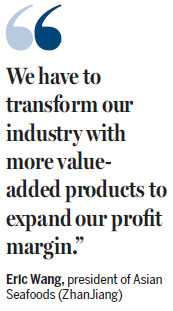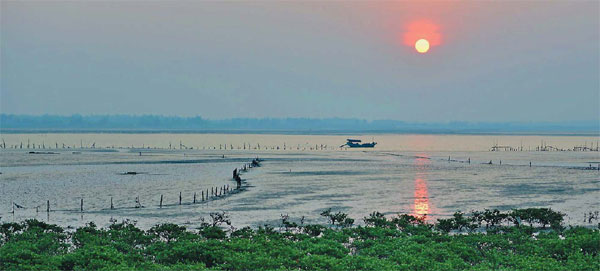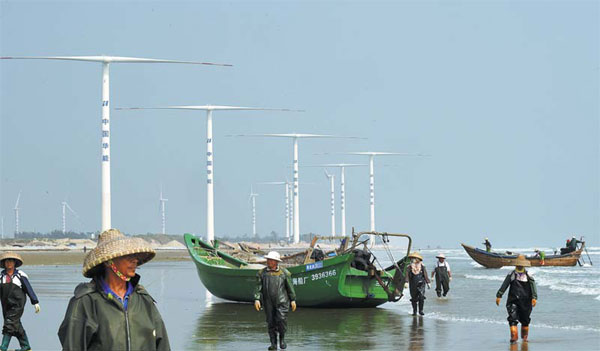Seafood industry adapts to market changes
Declining global demand, rising labor costs force firms to provide more value-added products
With China's seafood industry no longer enjoying a "golden era" amid soaring labor costs and shrinking demand from overseas countries, many seafood producers are keen to upgrade their products, according to industry experts.
"The golden age for the development of the seafood industry has already passed, and we are now in a period of stable growth," said Eric Wang, president of Asian Seafoods (ZhanJiang) Co, a major supplier of aquatic products for supermarket chains including Walmart and Parkson Retail Group.
"As a result, we have to transform our industry with more value-added products to expand our profit margin," he added.
Located in Zhanjiang, a production base for shrimps in China's Guangdong province, the company sells shrimp products, tilapia fillets and frozen fish products to the United States, Canada, Japan, Korea and several countries in Europe.
Wang said the company has two factories in China with different marketing strategies. The factory in Guangdong province serves as a production base for exports, while the other in Zhejiang province, is a major provider for the domestic market.
"Actually, 80 percent of the revenue of my factory in Zhanjiang comes from exports," he said.
Asian Seafoods (ZhanJiang) raked in about 67 million yuan ($10.79 million) last year, a double-digit growth compared with the previous year.
"We are now trying to keep that growth for business, but we did better in the past when demand from the global market kept increasing," Wang said.
Between 1999 and 2008, which Wang called a "golden age" for the aquatic industry, growth in revenue for the overall market went from 50 percent to 100 percent.
However, as labor costs have continued to soar and there has been declining demand from Western countries, profits for many Chinese aquatic companies have shrunk quickly.

Wang said that to cope with the situation, his factory in Zhanjiang is launching more added-value products.
"We are now putting more effort into processing products such as breaded shrimps and tilapia, cooked peeled shrimps and tilapia fillets, instead of raw shrimps and fish," he said. "It takes more time and effort to create the finished products so that we can have a better deal."
Xie Wei, secretary-general of Zhanjiang Association of Cold-chain Logistics, which was set up earlier this year to provide logistics services to aquatic companies, said the role of the seafood companies in Zhanjiang is set to change, as many are moving from being pure raw seafood exporters to seafood product processing companies.
"We can't rely on the previous model for growth because the market has changed," he said. "Thus there is a lot of room for improvement such as efficiency and technology in how to process the products."
He added that there are more opportunities in the domestic market with the growing appetite for seafood products from the country's middle class.
A report from the Rabobank Group shows that the past two decades have seen China become a major seafood provider for the world, while the next two decades will see the country shift into a big consumer of seafood products.
"China is already the driver of global seafood, both in import and production, and I think the subsequent impact on the whole industry will be profound," Xie said.
lvchang@chinadaily.com.cn
|
A view of the coastal city of Zhanjiang in southwestern Guangdong province. Photos Provided to China Daily |
|
With rising labor costs and declining global demand, the seafood industry in Zhanjiang is evolving, with many companies moving from being pure raw seafood exporters to seafood product processing companies, industrial experts say. |
(China Daily 07/14/2015 page7)
















